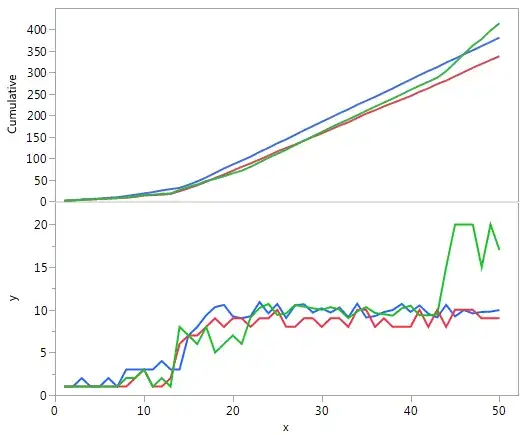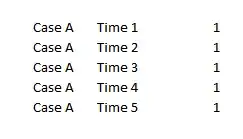To simplify the issue: let the board be one-dimensional of size $1 \times n$.
Equivalent problem
For each $k$-th step number we can ask the following equivalent question:
- In how many ways can we distribute the $k$ stones such that only 2 or 3 are touching together (more or bigger groups are not a valid end-states). These are the possible end states.
- Then you have to consider in addition the number of ways to place the stones on the board such that one of the two touching or the middle of the three was the last stone placed on the board.
Gaps
The distribution question is equal to finding sufficient non-zero gaps between the stones. With $k$ stones, where 2 touch each other (for which there are $k-1$ ways, e.g the stones that touch are the 1st and the 2nd until the k-1-th and the k-th), there need to be $k-2$ gaps in between them and there are between $k-2$ and $n-k$ squares to use for this (the process should be stopped before $2k\geq n+2$). This is not a definite number because the outside stones may not need to touch the sides.
Let there be $l$ squares to be distribute among $k-2$ non zero gaps. The number of ways to do this is
$$f(l,k-2) = \dbinom{l-1}{k-3} $$
(see https://math.stackexchange.com/questions/58753/unique-ways-to-keep-n-balls-into-k-boxes )
Counting the ways to get to finish with adjacent pair in $k$ steps
For the $l$ squares to be distributed in between the stones there are $n-k-l$ squares on the sides which can be split in $n-k-l+1$ ways.
So the number of end situations/states with $k$ stones is:
$$ N_{2states}(k) = \begin{cases} n-1 & \qquad \text{for } k=2 \\
\sum_{l=k-2}^{l=n-k} (k-1) (n-k-l+1) \dbinom{l-1}{k-3} & \qquad \text{for } k>2 \end{cases}$$
$$ N_{3states}(k) = \begin{cases} n-2 & \qquad \text{for } k=3 \\
\sum_{l=k-3}^{l=n-k} (k-2) (n-k-l+1) \dbinom{l-1}{k-4} & \qquad \text{for } k>3 \end{cases}$$
The number ways to end in these states is (such that one of the two adjacent stones or the middle of the three was in the last step):
$$N_{endings}(k) = N_{2states}(k) \cdot 2 (k-1)! + N_{3states}(k) \cdot (k-2)!$$
So the probability to end in $k$ steps is
$$P(k) = \frac{N_{endings}(k)}{n!/(n-k)!}$$
If you would wish to stick a name to this distribution than you could call it a sum of negative binomial distributions (ie. how long it takes before a success/failure), but with varying probabilities each step (success becomes more likely with more stones)

 If someone knows which distribution it is, I'm all ears.
If someone knows which distribution it is, I'm all ears.